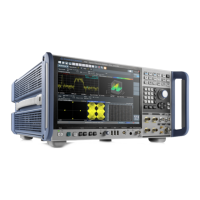Measurements and Results
R&S
®
FSW
171User Manual 1173.9411.02 ─ 43
Results are provided for the Tx channel and the number of defined adjacent channels
above and below the Tx channel. If more than one Tx channel is defined, the carrier
channel to which the relative adjacent-channel power values should be referenced
must be defined (see "Reference Channel" on page 171).
Note: If several carriers (Tx channels) are activated for the measurement, the number
of sweep points is increased to ensure that adjacent-channel powers are measured
with adequate accuracy.
For more information on how the number of channels affects the measured powers,
see Chapter 7.2.2, "Channel Power Results", on page 153.
Remote command:
Number of Tx channels:
[SENSe:]POWer:ACHannel:TXCHannel:COUNt on page 847
Number of Adjacent channels:
[SENSe:]POWer:ACHannel:ACPairs on page 844
Reference Channel
The measured power values in the adjacent channels can be displayed relative to the
transmission channel. If more than one Tx channel is defined, define which one is used
as a reference channel.
Tx Channel 1 Transmission channel 1 is used.
(Not available for MSR ACLR)
Min Power Tx Channel The transmission channel with the lowest power is used as a reference channel.
Max Power Tx Chan-
nel
The transmission channel with the highest power is used as a reference channel
(Default).
Lowest & Highest
Channel
The outer left-hand transmission channel is the reference channel for the lower
adjacent channels, the outer right-hand transmission channel that for the upper
adjacent channels.
Remote command:
[SENSe:]POWer:ACHannel:REFerence:TXCHannel:MANual on page 851
[SENSe:]POWer:ACHannel:REFerence:TXCHannel:AUTO on page 851
Noise Cancellation
The R&S FSW can correct the results by removing the inherent noise of the analyzer,
which increases the dynamic range.
In this case, a reference measurement of the inherent noise of the analyzer is carried
out. The measured noise power is then subtracted from the power in the channel that
is being analyzed (first active trace only).
The inherent noise of the instrument depends on the selected center frequency, resolu-
tion bandwidth and level setting. Therefore, the correction function is disabled when-
ever one of these parameters is changed. A disable message is displayed on the
screen. To enable the correction function after changing one of these settings, activate
it again. A new reference measurement is carried out.
Noise cancellation is also available in zero span.
Currently, noise cancellation is only available for the following trace detectors (see
"Detector" on page 584):
Channel Power and Adjacent-Channel Power (ACLR) Measurement

